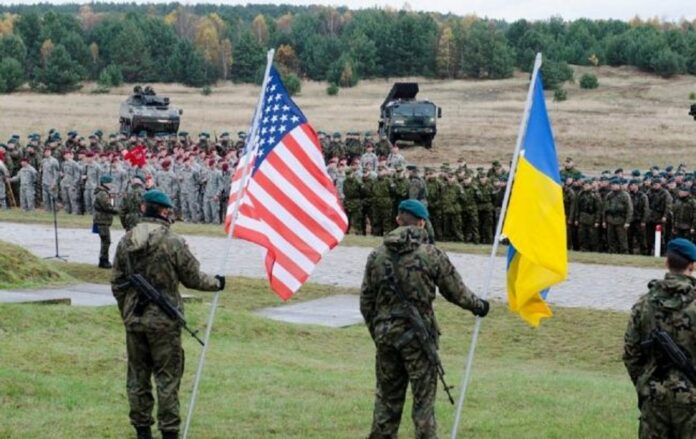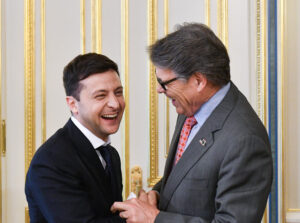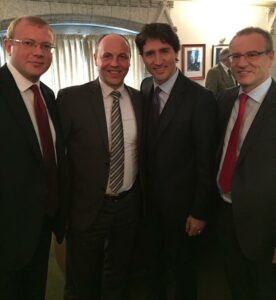
He who controls the media shapes public opinion, which helps win the war in the end. To help promote the Western view, the Financial Times took the unusual move of dropping its paywall while Russia Today and Sputnik were banned. Now the U.S. Republican senators who refused to sign the Congressional bill for military aid to Ukraine are being publicly pilloried, as are the companies who refuse to get out of Russia.
1) Demonizing Putin
The Western media and politicians are focusing on Putin. They make him appear alternately mad, nostalgic of Russia’s heroic past, and, especially, acting alone – which is far from being the case as we saw in a previous article, a view summarized by none other than Biden’s CIA director, William J. Burns, who said back in 2008 when U.S. ambassador to Moscow: “Ukrainian entry into NATO is the brightest of all redlines for the Russian elite (not just Putin). In more than two and a half years of conversations with key Russian players, from knuckle-draggers in the dark recesses of the Kremlin to Putin’s sharpest liberal critics, I have yet to find anyone who views Ukraine in NATO as anything other than a direct challenge to Russian interests.“
“Putin may have ‘lost touch with reality,’ expert says,” titled Michael Isikoff, Yahoo News Chief Investigative Correspondent, formerly at NBC News and Newsweek, right after the war started. “’He Has Changed’: Putin’s Words And Actions Raise Questions About His Rationality,” said Steve Gutterman from Radio Free Europe/Radio Liberty. Former Secretary of Defense Robert Gates told CNN it seemed like Putin has “gone off the rails.”
“This is a different Putin,” former Secretary of State Condoleeza Rice recently told Fox News. “He was always calculating and cold, but this is different. He seems erratic.”
“Putin ‘a war criminal’ and should be tried at Hague, Lindsey Graham says”, reported Alexander Nazaryan, Senior White House Correspondent at Yahoo News.
“Putin is increasingly operating emotionally”, said one of the most quoted “experts”, Fiona Hill. “Every time you think, ’No, he wouldn’t, would he?’ Well, yes, he would,” she said. And the former director for European and Russian affairs on the National Security Council under Donald Trump and national intelligence officer for Russia and Eurasian affairs under Barack Obama and George W. Bush, as well as Putin biographer, went on: “This visceral emotion is unhealthy and extraordinarily dangerous because there are few checks and balances around Putin. He spotlighted this during the performance of the National Security Council meeting, where it became very clear that this was his decision. He was in a way taking full responsibility for war, and even the heads of his security and intelligence services looked like they’ve been thrown off guard by how fast things were moving.”
Others, such as Massachusetts Institute of Technology historian Elizabeth Wood, go further. She wrote in 2011: “By making the war [WWII] a personal event and also a sacred one, Vladimir Putin has created a myth and a ritual that elevates him personally, uniting Russia (at least theoretically) and showing him as the natural hero-leader, the warrior who is personally associated with defending the Motherland. He has the glamour of the present, but he is also the hero of the past.”
Putin is very ‘concentrated,’ ‘calculated’ and ‘persistent’
Behind the man is a strategic reality that supersedes any superficial human characteristic. It seems, instead, that Putin has a clear vision and the discipline required to implement it – unlike, by the way, any contemporary Western/European leader, subservient to the U.S.. John Bolton, one of the U.S. security establishment’s most hawkish and long-time officials, told the BBC: “I know there are a lot of theories and speculation going around that Putin has a screw loose. I don’t think so. I think he’s a cold, hard, calculating man.” Andrei Illarionov, who served as an economic adviser to Putin from 2000 to 2005, also said he does not think that Putin’s behavior is demonstrating that he’s “losing his mind.” He told Newsmax‘s Sean Spicer and Lyndsay Keith on Mar. 3 that “Putin is very ‘concentrated,’ ‘calculated’ and ‘persistent.’”
Finally, Kenneth Dekleva, a psychiatrist who previously worked at the U.S. Embassy in Moscow (!) and specializes in leadership analysis/political psychology profiling for national security purposes, said: “The Russian leader’s decision to attack Ukraine is not evidence of some kind of instability.”
Of course, if you ignore history and just look emotionally at the current events, you won’t understand what is going on, and the whole affair will seem crazy to you.
2) Ukraine’s Military Build-Up and NATO’s presence
I watched the whole Feb. 21 meeting of Russia’s National Security Council (just over one hour and a half) and it seemed like a class with Putin presiding at a table – at a safe distance (coronavirus) – and the Council members each on a chair, in a semicircle, coming to the podium, one by one, called by a headmaster, drawing his authority from his 22 years in power. Each member, from Dmitry Medvedev, Deputy Chairman of the Security Council, Sergei Shoigu, Minister for Defense, to Sergei Lavrov, Minister for Foreign Affairs, and half a dozen others looked a bit like schoolboys reciting their lesson, in a verbose speech, and at the end agreeing that there was no more room for further negotiations, specifically on the matter of the recognition of the Donetsk and Luhansk republics.

They were referring to the 2014 and 2015 Minsk agreements signed by Ukraine, Russia, and the Eastern Ukraine separatists, as well as a representative of the Organization for Security and Co-operation in Europe (OSCE), with mediation from Germany and France. The goal was to put an end to the bloody fight between the Ukrainian army and the pro-Russian separatists in the eastern part of the country, which had started after the 2014 Maidan coup that overthrew constitutionally elected president Viktor Yanukovych. The Minsk agreement would have also put Ukraine on the way to a constitutional reform and a federation with more decision power to the regions, specifically the eastern provinces of Donetsk and Luhansk, where the population is overwhelmingly of Russian descent and language.
This was especially significant for the latter and for Russia if, under a federative form, it had evolved into the eastern provinces being able to veto any decision of the central government, including on cultural (keeping Russian as a language) and political (blocking entry into NATO) matters. That would have meant a de facto neutrality of Ukraine (and likely lots of political stalemates/dead ends). The agreements were never implemented, nor did Germany/France ever put pressure on the Kiev government – which simply ignored them – possibly hoping to tip Ukraine to their side, the EU.
On another track, Russia had been pressuring NATO, lately with urgency, to get security re-assurances that Ukraine would remain neutral and not get nuclear arms. President Zelensky had made clear his Western orientation, making his first official trip abroad as president to the NATO headquarters in Brussels on Jun. 4, 2019, exactly two weeks after he assumed office. He called Putin one week later, proposing to hold a meeting with the participation of the leaders of Germany, France, the United States, and the United Kingdom. (Incidentally, the USA was represented at Zelensky’s inauguration by the secretary of energy, Rick Perry, former governor of Texas.)
the USA gave ukraine one billion dollars in military aid in 2021
NATO never responded to Moscow and the U.S. continued to brazenly pour military aid into Ukraine – with an acceleration under Trump to include “defensive” weapons – for a total of $2.7 billion since 2014, one billion of which just in the past year, 2021. This makes “Ukraine among the most significant recipients of U.S. military aid, ranking 7th globally between FY2016-FY2020 and the largest such recipient in Europe, according to the Security Assistance Monitor. Beyond the dollar amounts, the U.S. has provided foreign military training to at least 10,629 Ukrainian trainees between FY2015-FY2019,” as reported by the Stimson Washington DC think tank. To which we should add the CIA training of special Ukrainian forces on U.S. soil, which the public learned of only a few days ago.

As for military exercises, the latest was the Rapid Trident on Sep. 20, 2021 in the Western Ukrainian city of Lviv, in which 6,000 military personnel from 15 countries participated, including a Lithuanian-Polish-Ukrainian brigade, a brigade combat team of the Washington National Guard, which has been deployed in Ukraine since April. According to the press service of Ukraine’s Defense Ministry, these exercises were meant “to improve the level of interoperability between units and headquarters of the Armed Forces of Ukraine, the United States, and NATO partners,” as well as being an “important step towards Ukraine’s European integration.”
I can’t but wonder what the U.S. government would do if Russia (or China) and 15 countries were to organize military exercises in Durango, Mexico, which is at about the same distance (600 km) from the U.S. as Lviv is from the Russian border, plus pour billions of dollars of weapons in that neighboring country. The U.S. already feels threatened by caravans of poor immigrants heading north.
On Feb. 19, Zelensky spoke at the 58th Munich Security Conference where Western leaders discussed about threats and dangers. The Ukrainian president requested “clear, feasible timeframes” for Ukraine to join the U.S.-led NATO military alliance, as well as “‘specific steps,’ alluding to Ukraine’s requests for even more military and economic assistance.”
At the Feb. 21 National Security Council meeting, the Russians concluded there was no point in continuing diplomacy, but they also saw the clock ticking, with the West building up Ukraine militarily. They felt their window of opportunity was closing. They knew the risk they were undertaking, of many more economic sanctions and international opprobrium, but they felt that the costs of doing nothing now was higher than the costs of doing something.
On the very day of the security meeting, Putin followed up on the Feb. 15 Russian Duma vote and recognized the self-proclaimed Donetsk People’s Republic and Luhansk People’s Republic. Three days later, on Feb. 24, the Russian tanks rolled into Ukraine with the objective to remove the government and achieve neutrality.
6,000 military personnel from 15 countries do military exercises under nato in western ukraine
3) A trap?
Now, some observers talk about a trap, for Russia has been attacked with “novel” and “swift and total” sanctions which make Philippe Raxhon, professor of contemporary history at Liège University in Belgium, wonder: “what is the real purpose of these sanctions? Fight a belligerent autocrat or bring down a historic rival, especially of the United States?”
This past January, Five Colleges professor of Peace and World Security Studies at the University of Massachusetts Amherst, and defense correspondent of The Nation magazine, Michael Klare said this about the current encirclement of China: “The gigantic 2022 defense bill — passed with overwhelming support from both parties — provides a detailed blueprint for surrounding China with a potentially suffocating network of U.S. bases, military forces, and increasingly militarized partner states. The goal is to enable Washington to barricade that country’s military inside its own territory and potentially cripple its economy in any future crisis. For China’s leaders, who surely can’t tolerate being encircled in such a fashion, it’s an open invitation to… well, there’s no point in not being blunt… fight their way out of confinement.”

Other high U.S. officials use the word “provocation,” and first of all none else than (as mentioned earlier) the current CIA director, William J. Burns, Under Secretary and Acting Secretary of State under George W. Bush and Obama, who “has been warning about the provocative effect of NATO expansion on Russia since 1995.” When President Bill Clinton’s administration moved to bring Poland, Hungary, and the Czech Republic into NATO, Burns then a political officer in the U.S. Embassy in Moscow, wrote that the decision was “premature at best, and needlessly provocative at worst.”
The provocations led to a first attack, in 2014. Ted Galen Carpenter, a senior fellow in defense and foreign policy studies at the Cato Institute in Washington, DC, says that “the Obama administration’s shockingly arrogant meddling in Ukraine’s internal political affairs in 2013 and 2014 to help demonstrators overthrow Ukraine’s elected, pro-Russia president was the single most brazen provocation”, leading to the annexation of Crimea.
Then, after the 2016 NATO summit in Warsaw, Poland, Mikhail Gorbachev, the last Soviet leader praised for ending bloodlessly the Cold War, said that “the rhetoric in Warsaw screams of an intention to practically declare war on Russia. They only talk about defense, but in fact they are preparing an offensive.”
If this is the case, it was a brilliant move: make Russia feel that the U.S. only understands force (talk peace, act war, as they do with Palestine), build-up Ukraine, heat up the parties with news of an imminent invasion, and then push Russia into checkmate. Russia would lose either way: militarily if they didn’t react, or economically and politically if they did. Russia reacted.
russia would lose militarily if it did not react, or economically and politically if it did
That is the last move of this post-Cold War era, which started with Russia hoping, ironically, to become a member of NATO, especially in 1993 under Boris Yeltsin. (President Bill Clinton agreed, but the U.S. deep state did not.) Instead, under the push of the U.S. which was afraid of a united Europe from the Atlantic to the Urals, the West rejected Russia’s bid, assuming it to be a threat to democracy and bribed it with financial aid during these post-Soviet times of hardship to accept its former allies getting into NATO. In her recent book “One Inch: America, Russia, and the Making of Post-Cold War Stalemate,” Mary Elise Sarotte, professor of historical studies at Johns Hopkins University argues that “Washington won its power battle over enlargement, but in a way that led to confrontation, not cooperation, with Moscow.” As a Belgian commentator wrote: “It’s a bit like beating your dog saying he’s mean. Then one day he bites you, and you say: here’s the proof of his meanness.”
4) NATO’s selfishness, helplessness, and the sacrifice of yet another population
Build-up Ukraine, then desert it. One significant aspect that has angered – and still surprised – people all over the globe is the non-involvement of NATO forces in Ukraine, including not imposing a no-fly zone and not even transferring Polish MiG-19 jets, under the excuse that Ukraine is not a member of NATO. Yet they did get involved in Afghanistan – way out of the Alliance’s territory – when the U.S. pretended the Taliban was a security threat, invoking Article 4 of the NATO Charter. But here they have to deal with Russia. And they never intended – nor have the resources nor even the coordination as the Afghan debacle revealed – to help Ukraine. So, Scott Ritter, former U.S. military intelligence officer and UN nuclear inspector in Iraq, asks the U.S. the reason for years of military build-up: “Why do you set Ukraine up like this if you’re never going to let them be a member and you know that the Russians have made it their red line, which isn’t something new. We’ve been setting Ukraine up from the very start to be the fall guy.” So why? To hit its declared adversary, Russia, without directly involving the U.S., at the cost of the Ukrainian population.
After 12 days of combat Zelensky finally got it. In an exclusive interview ABC News on Mar. 7, he said his mindset changed “after we understood that NATO is not prepared to accept Ukraine,” and he added: “The alliance is afraid of controversial things and confrontation with Russia.” He also signaled some flexibility on these issues, saying Ukraine was ready to “discuss with Russia the future of Crimea and Donbas.” Of course, the former comedian is very good at pleading and pushing the world (he keeps repeating that Europe and the world is attacked) and one might interpret it as a threat: If you don’t help me, I’ll flip sides!
As Professor Raxhon concluded, if it is the case of the USA aiming to bring down Russia: “Ukraine will then have experienced two historical misfortunes, that of being invaded and that of being a pretext.”










